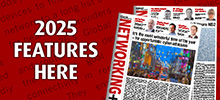03 February 2023

An NHS trust was in dire need of strong, reliable mobile network signal at two of their hospitals. Based across eleven London boroughs and Hertfordshire, this trust provides community health services to more than two million people. With one location being badly affected by the COVID-19 pandemic, the project had to be carried out fast, without severe disruption to either premises.
A mobile first strategy
Like most healthcare providers in the UK, the trust has started to move towards a ‘mobile first’ strategy, with everything from patient records to colleague communications relying increasingly on mobile connections. Mobile has become such an integral part of healthcare, especially during the COVID-19 pandemic, that the NHS has released official guidance on how staff and patients can use devices safely.
Digital services that need mobile data and calling to function include:
- Accessing digital patient records on tablets and mobile phones (particularly important for outpatients to specialist units such as diabetes management clinics and maternity services)
- Communication between staff (especially those on emergency call)
- Communication between patients and their next of kin (something that rapidly became a priority as coronavirus prohibited visitors to wards)
- Organisation and digital planning (a rising number of nurses now use mobile devices to plan rotas and patient visits)
While WiFi can offer a partial solution, it’s often inconsistent across an entire hospital building, especially for hospitals that are arranged in blocks with walkways and outside spaces between wards and facilities. These ‘drop zones’ are not only inconvenient but can delay emergency communications.
Moreover, healthcare buildings are among the worst affected by poor mobile coverage, with 82% of workers reporting bad signal in a recent study, so relying on existing network coverage was not an option. While this poor coverage can be attributed to location, it is mostly the result of building layouts and materials such as brick, glass and metal obscuring signal.
“The new solution has transformed a user experience where there was either no coverage or a patchy, weak signal, to a consistent coverage with a high data throughput.”
Transforming user experience
As one of the hospitals was particularly badly hit by coronavirus, access to digital services for both staff and patients had suddenly become a significant priority. The solution needed to be fast, without causing disruption to busy wards.
By installing Cel-Fi QUATRA signal boosters, UCtel could quickly bring reliable coverage from multiple networks into the premises. Cel-Fi does not interfere with existing wireless products, making it safe to use alongside hospital equipment. Authorised by 200 mobile carriers, Cel-Fi automatically adjusts to changing network conditions, so that the hospitals can rely on network coverage regardless of environmental changes.

Several surveys were carried out to determine the quantity and location of the Cel-Fi QUATRA units to provide the required coverage. UCtel’s team of engineers installed new cabling throughout the hospital building to connect the system and tuned it to deliver the optimal signal.
The new solution has transformed a user experience where there was either no coverage or a patchy, weak signal, to a consistent coverage with a high data throughput. Both hospitals now have reliable network coverage, allowing healthcare professionals, administrators, and patients to access digital services and stay connected.








